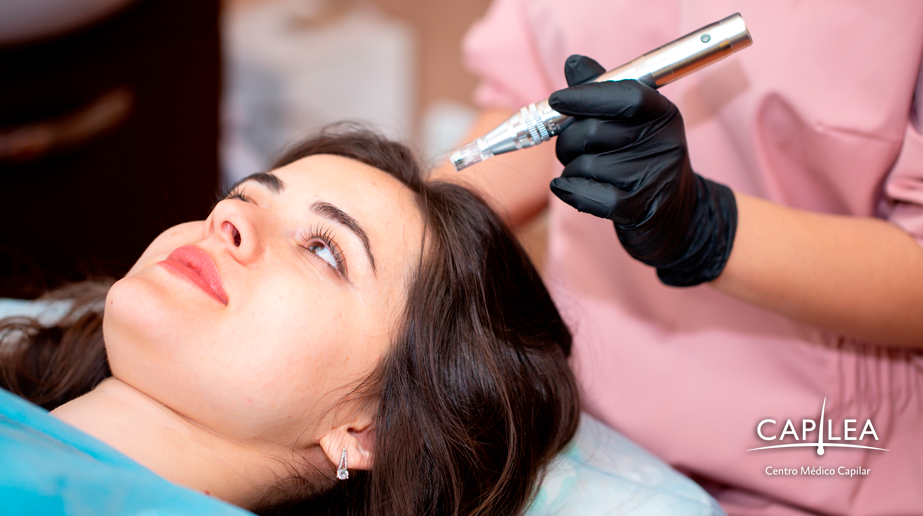Losing hair can be stressful and may cause embarrassment, especially when it happens at the front of your head. Alopecia is a common cause of hair loss, but it can be tricky to understand what may be causing it. You’re not alone if you’re a woman with female pattern hair loss at the front of your head. In this blog post, we’ll explain alopecia and explore why you may be experiencing hair loss at the front of your scalp.

Alopecia? What is it?
Alopecia is a medical condition that causes hair loss. It can appear in different forms, and one of the most common types is androgenic alopecia. This condition has a genetic component, which means it’s passed down from family members. Androgenetic alopecia affects both genders.
Another form of alopecia is called traction alopecia. This type of hair loss happens when you wear tight hairstyles like braids or a tight bun. The constant pulling on the hair follicles can cause damage, leading to hair loss at the front of the head. Also, harsh chemicals like relaxers or dyes and heat styling can further exacerbate hair loss or thinning.
Sudden hair loss at the front of the head could also mean you have an autoimmune disorder called alopecia areata. This condition can cause hair to fall out in patches, including the hairline. Medical professionals believe the immune system attacks hair follicles, although the exact cause remains unknown. We can treat alopecia areata with medications or hair transplant procedures.
Lifestyle factors
Habits could also contribute to hair loss at the front of your head. Poor nutrition, stress, and dehydration can lead to hair loss as these factors can weaken hair from the roots. To counteract this, try to incorporate a balanced diet rich in vitamins and minerals, stay hydrated, and find ways to manage stress. In women, it’s called female pattern hair loss; in men, it’s called male pattern hair loss.

How do I stop hair loss in front of my head?
Skip the creams and home remedies to treat hair loss; hair transplant is a procedure that relocates hair follicles from one part of the body (usually the back or sides of the head) to areas where hair is thinning. It’s safe and effective. The two most common are:
FUSS Technique
Follicular Unit Strip Surgery (FUSS), also known as Follicular Unit Transplantation (FUT), is a hair transplant technique that involves removing a strip of skin containing hair follicles from the back or sides of the scalp, known as the donor area. The strip is dissected into individual follicular units, small groups of hair follicles, usually containing 1 to 4 hairs each.
These individual follicular units are then carefully transplanted into the recipient area, where thinning or balding has occurred.
FUE Technique
Follicular Unit Extraction (FUE) is a hair transplant technique that involves individually extracting hair follicles from the donor area, typically the back or sides of the scalp, and then transplanting them into the recipient area where thinning or balding has occurred. The procedure aims to create a natural-looking hairline and fuller appearance by placing the hair follicle unit in a way that mimics the patient’s original hair growth pattern.
It’s essential to consult with a qualified and experienced hair transplant surgeon to determine the best hair restoration technique for your specific needs and expectations.

Benefits of hair transplant
Hair transplant surgery can benefit individuals experiencing hair loss or thinning hair. Some key advantages include:
Permanent solution
Unlike temporary solutions such as wigs, hairpieces, or topical treatments, hair transplantation offers a long-lasting solution to hair loss by addressing the problem at its root -the lack of healthy hair follicles, and supporting the hair growth cycle.
Natural-looking results
Modern hair transplant techniques, such as Follicular Unit Extraction (FUE) and Follicular Unit Strip Surgery (FUSS), aim to create a natural-looking hairline and density by transplanting individual follicular units that mimic the original hair growth pattern.
Improved self-esteem
A successful hair transplant can help restore a natural-looking hairline and fuller hair, boosting self-confidence and enhancing the overall appearance.
Low maintenance
Once the transplanted hair grows, it requires no special care or maintenance. You can treat it like the rest of your natural hair – washing, styling, and cutting as desired.
No need for chemical products or medical treatments
Hair transplants don’t need continual use of chemicals or medication to keep hair growing, which can help those wishing to avoid potential side effects from these treatments.
Having realistic expectations and consulting with a qualified hair transplant surgeon to discuss your specific needs and goals before undergoing the procedure is essential. The surgeon will help you determine the best hair restoration technique and develop a personalized treatment plan.

Hair loss (front of head, female) can be difficult, but it’s essential to understand the cause to know how best to address it. Alopecia can stem from multiple factors, including genetics, health conditions, and lifestyle factors. Ensure that you’re caring for your hair gently and seek professional advice to help you determine the underlying cause and provide an effective hair transplant to stop hair loss and regrow hair. Remember, you can make your hair grow again, feel more confident, and forget about hair loss with a hair transplant, patience, and care.
At Capilea, we perform hair transplants for female and male pattern baldness with tremendous natural and permanent results. Our highly experienced team is ready to help you. Start your hair recovery and boost your confidence. The first appointment is free! Schedule now.

















